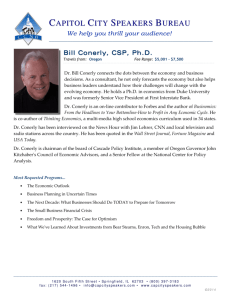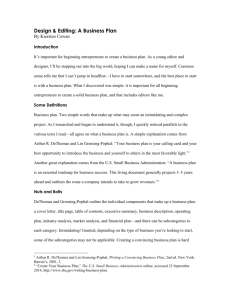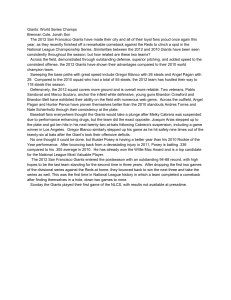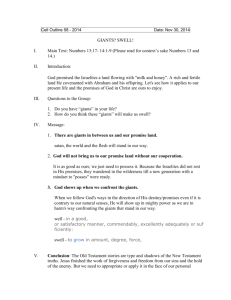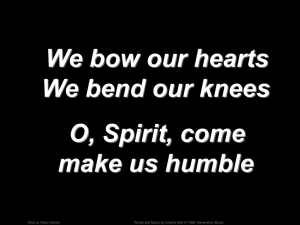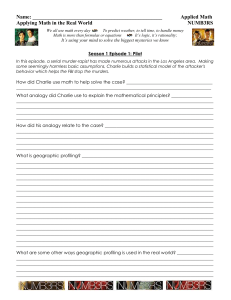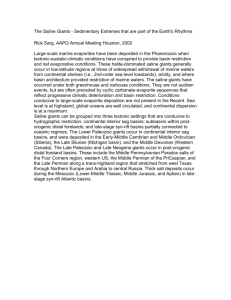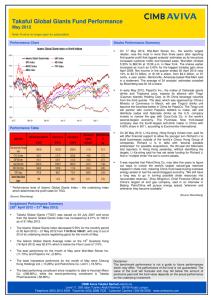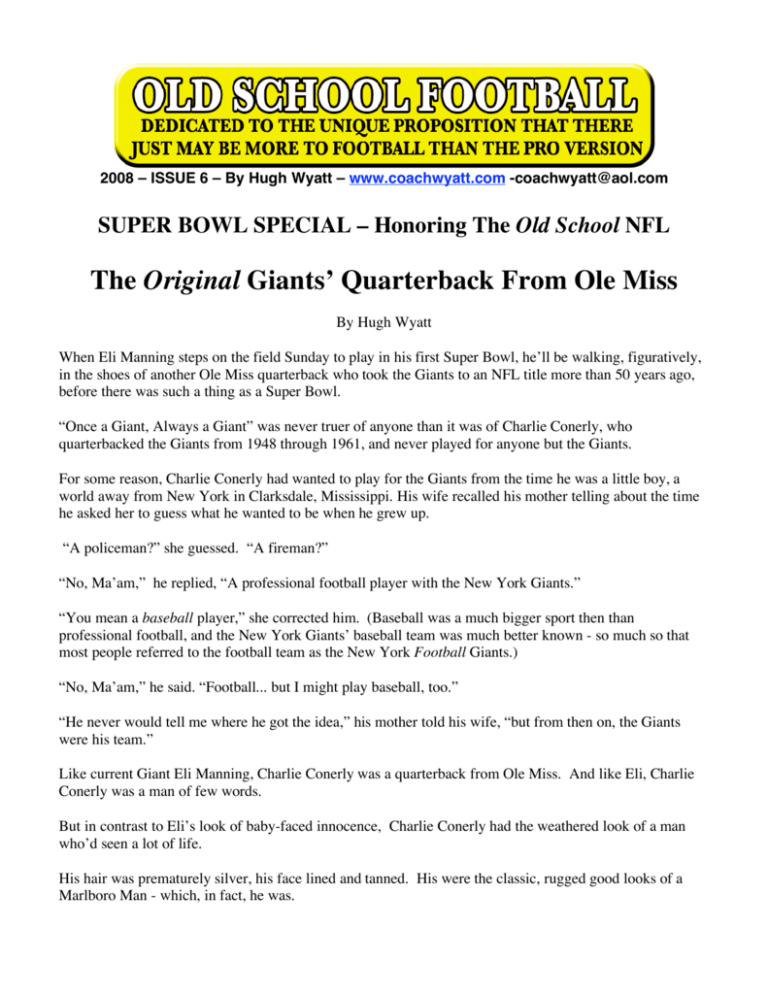
2008 – ISSUE 6 – By Hugh Wyatt – www.coachwyatt.com -coachwyatt@aol.com
SUPER BOWL SPECIAL – Honoring The Old School NFL
The Original Giants’ Quarterback From Ole Miss
By Hugh Wyatt
When Eli Manning steps on the field Sunday to play in his first Super Bowl, he’ll be walking, figuratively,
in the shoes of another Ole Miss quarterback who took the Giants to an NFL title more than 50 years ago,
before there was such a thing as a Super Bowl.
“Once a Giant, Always a Giant” was never truer of anyone than it was of Charlie Conerly, who
quarterbacked the Giants from 1948 through 1961, and never played for anyone but the Giants.
For some reason, Charlie Conerly had wanted to play for the Giants from the time he was a little boy, a
world away from New York in Clarksdale, Mississippi. His wife recalled his mother telling about the time
he asked her to guess what he wanted to be when he grew up.
“A policeman?” she guessed. “A fireman?”
“No, Ma’am,” he replied, “A professional football player with the New York Giants.”
“You mean a baseball player,” she corrected him. (Baseball was a much bigger sport then than
professional football, and the New York Giants’ baseball team was much better known - so much so that
most people referred to the football team as the New York Football Giants.)
“No, Ma’am,” he said. “Football... but I might play baseball, too.”
“He never would tell me where he got the idea,” his mother told his wife, “but from then on, the Giants
were his team.”
Like current Giant Eli Manning, Charlie Conerly was a quarterback from Ole Miss. And like Eli, Charlie
Conerly was a man of few words.
But in contrast to Eli’s look of baby-faced innocence, Charlie Conerly had the weathered look of a man
who’d seen a lot of life.
His hair was prematurely silver, his face lined and tanned. His were the classic, rugged good looks of a
Marlboro Man - which, in fact, he was.
Almost from the time he joined the Giants, he looked older than his teammates - but then, he was. He was a
27 year-old rookie. Eli Manning, who turned 27 earlier this month, is nearing the end of his fourth season.
But when Charlie Conerly joined the Giants as a rookie, he had already spent four years in college and
three years as a Marine in the South Pacific.
Conerly was a high school football star in Clarksdale, and although he started out at Ole Miss in 1941, he
wouldn’t graduate from there until 1948. Sandwiched in between was World War II service in Guam and
Iwo Jima. (His wife still has the clip from the rifle that was shot out of his hands by a Japanese sniper.)
Back at Ole Miss following the war, the Rebels went 2-7 in 1946, and were picked to finish no better than
10th in the Southeastern Conference in 1947. But under new coach Johnny Vaught, the Rebels won the
conference championship, their first ever. It didn’t hurt that Vaught had Charlie Conerly as his single-wing
tailback throwing the ball, and a big end named Barney Poole catching it.
(Thanks to the strange eligibility rules that existed during wartime, Poole played seven years of college
football - a year at Ole Miss followed by another at North Carolina, then three years at West Point and a
final two at Mississippi. The story goes that when the war ended he asked Army coach Earl Blaik to release
him so he could return to Mississippi, and when Coach Blaik refused, Poole deliberately flunked out of the
Military Academy.)
Ironically, with a poor 1947 season forecast, Mississippi had taken no chances and accepted a bowl bid in
advance - to something called the Delta Bowl, in Memphis. Had they only known how the season would
turn out, they would have played in the more prestigious and lucrative Sugar Bowl, but the Rebels honored
their commitment to the Delta Bowl, where they beat TCU, Vaught’s alma mater, 13-9. The Delta Bowl
would last just one more year, and in an age when bowls were few and bowl bids rare, it would be another
five years before the Rebels would go to another bowl game.
Conerly led the nation in passing in 1947, setting new NCAA records for completions (133 in 232
attempts), yards (1367) and consecutive passes without an interception (61). In all, he threw for 18
touchdowns. His passing records would remain Ole Miss standards until 1969, when they were broken by a
young man named Archie Manning from Drew, Mississippi, some 20 miles from Clarksdale. Archie, as
everyone now knows, is Eli’s dad.
A true single wing tailback, Conerly also rushed 104 times for 417 yards and nine touchdowns. A true
triple threat, he punted 58 times for a 40.2 yard average.
Conerly finished fourth in the Heisman voting, in a year when voters were presented with as difficult a
choice as any in the history of the award. Ahead of him were Johnny Lujack, quarterback of unbeaten
Notre Dame, Bob Chappius, tailback of unbeaten Michigan and Doak Walker, SMU’s incredible
sophomore; trailing him were Alabama quarterback Harry Gilmer, Texas quarterback Bobby Layne, and
Penn center Chuck Bednarik.
He was an outstanding baseball player, too, batting .467 his senior season, but baseball was never in his
plans. He was going to be a professional football player. And, as things worked out, for the New York
Giants.
In 1945, while he was away at war, the Washington Redskins had taken advantage of the fact that his
original college class had graduated, and drafted him. (He received the telegram informing him of this
while stationed in Guam.) But the Redskins’ passing game was already in the able hands of Sammy
Baugh, and after using their top draft choice in 1948 to select Alabama’s Gilmer to be their quarterback of
the future, the Skins traded the rights to Conerly to the Giants.
There was a battle going on at the time between the NFL and the All-American Football Conference, and
much was made of the claim by the Brooklyn Dodgers of the AAFC that they’d offered Conerly the thenhuge sum of $100,000, but Conerly signed with the Giants instead.
“They’ll probably be around a while longer,” he told his wife-to-be, “and who knows what will happen to
the new league?” Good judgment - the Dodgers were toast after the 1948 season, and the AAFC itself was
gone after 1949.
Ever practical, he used his signing bonus as a down payment on 225 acres of farmland south of Clarksdale.
He had a successful rookie year statistically, throwing for 2175 yards, more than any passer in the NFL
except Baugh (and 2106 yards more than Gilmer!) and earning Rookie of the Year honors. He threw 22
touchdown passes, a rookie record that would last for 50 years.
But the Giants finished 4-8.
And while productive enough out of Steve Owen’s A-formation – throwing for 22 touchdowns and only 13
interceptions - he paid a terrible physical toll. He wasn’t a very good runner, and the Giants’ line just
couldn’t protect him.
Despite Conerly’s impressive passing stats, Owen was forced to admit that his prized A-formation was no
longer effective, and in 1949, Giants’ assistant Allie Sherman was charged with converting Conerly into a
T-formation quarterback. Conerly proved to be a quick learner. The transition was successful, and one
after another, Conerly beat back the challenges of younger quarterbacks the Giants continued to draft.
But the protection still wasn’t there. Although sacks were yet not kept as a statistic then, the Philadelphia
Daily News reported that in one 1952 game against the Eagles, Conerly was sacked 17 times.
The Giants finished with 3-9 record in 1953, and Conerly threw a league-high 25 interceptions. Banners
reading "Goodbye, Charlie," and "Get a New Quarterback" had begun appearing in the stands, and
disgruntled fans would wait outside the locker room to heap further abuse on him as he exited. He wasn’t
about to give them the satisfaction of a response, but his buddy, halfback Frank Gifford, wasn’t so reticent,
and took a punch at one of them. Gifford, recalled how he and Conerly (“my best friend”) had attended a
New York Rangers’ hockey game, and when they were introduced over the PA system, the crowd lustily
booed at the mention of Conerly’s name.
Part of Conerly’s problem with the fans, Gifford would write later in his book, “Gifford on Courage” (an
entire chapter of which is devoted to Charlie Conerly), was that, “like many natural athletes, he made
everything look deceptively easy, almost casual.”
To many fans, that came across as not caring. Fans especially like the spectacular player, the one with the
flair for the dramatic, and that simply was not Charlie Conerly. “Charlie was never terribly impressed
when he succeeded in a play or in a game,” Gifford wrote. “You could never tell by looking at his face if he
had thrown a 60-yard pass or if the ball had been intercepted.”
Seeing little future with the Giants, a disappointed Conerly, now 32 years old, retired and went back home
to Mississippi. Back to being “Roach” Conerly.
(At home in Clarksdale, he went by “Roach,” a boyhood nickname of uncertain origin. While at Ole Miss,
southern newspapers had called him “Chunkin’ Charlie” and “Chunkin’ Chuck.” But not “Chuckin’
Charlie.” His wife noted that in the South, people always said “Chunkin’”. During his NFL career, he was
sometimes called “Chuck,” but more often Charlie - “With an ‘i-e’, not an ‘e-y’” his wife pointed out. His
wife called him Charles. In public, that is. That’s what his mother had called him. Back home in
Clarksdale, though, she called him “Roach,” just like everyone else.)
In the off-season, though, the Giants hired a new head coach, Jim Lee Howell. Howell had been an
assistant to Steve Owen for the previous five years, and he took three big steps that would change the
Giants’ fortunes.
First, he hired Vince Lombardi from Earl Blaik’s staff at West Point to coach his offense (the term
“offensive coordinator” had not yet been coined).
Second, he persuaded defensive back Tom Landry to remain as a player-coach and take over his defense
(likewise “defensive coordinator”).
And third, he made a trip to Clarksdale, Mississippi to try to talk his quarterback into coming back.
“He was putting out fertilizer on his farm,” Howell recalled, “you know, wearing those high rubber farm
boots, and I asked him about coming back, and he told me he didn’t want to be hurt any more. I told him
I’d get him protection, and he said, ‘That’s all I want to know.’”
With Conerly back, surrounded by skilled players such as Gifford and Kyle Rote, Alex Webster and Bob
Schnelker, and protected by linemen such as Roosevelt Brown, Jack Stroud and Ray Wietecha, Lombardi’s
offense (and Landry’s defense, with the likes of Andy Robustelli, Roosevelt Grier, Dick Modzelewski and
Emlen Tunnell) began to turn the Giants into a championship team.
It wasn’t easy at first. Conerly, the veteran, hated training camp, viewing it as something scarcely worth
getting worked up over, while Lombardi, the rookie coach, thought every play, even in practice, should be
run as if the league championship were on the line. To Lombardi, Conerly appeared lackadaisical. To
Conerly, just five years younger than the new offensive coach, Lombardi was loud and boisterous.
Recalled Gifford, “Charlie had never been exposed to that kind of coaching passion – nor did he care for
it.”
Lombardi knew he had no option but to come to terms with Conerly. He knew that Howell, his boss, had
made that personal trip to Mississippi to persuade Conerly to return, and he was smart enough to realize
that there was no chance that Conerly would not be his quarterback.
Bit by bit, the quarterback and the coach got to know and understand each other. Lombardi came to
appreciate Conerly’s intelligence and leadership qualities, Conerly to appreciate Lombardi’s intelligence
and drive. And his willingness to listen. Lombardi began to visit Conerly and Gifford in the room they
shared at camp. Kyle Rote would often be there, too, and Lombardi would ask the veteran players their
opinions on various things that had gone on in practice that day.
As Gifford put it, “Vince served his pro apprenticeship with the Giants. He knew football, but he didn’t
know pro football… We had all come out of college ball and we had learned how much different and
harder the pro game was.”
As one example, in the early stages of their relationship, Lombardi insisted that Conerly run a belly option
play, one that had been very successful at West Point. The idea was that Conerly would fake a handoff to
his fullback. Thinking that the fullback had the ball, the defensive end would tackle him, but instead of
handing off to the fullback, Charlie would keep the ball and pitch it to another back. As Gifford related it,
the play worked beautifully in dummy scrimmage, much to the delight of Lombardi.
Conerly went along with the idea until the first contact scrimmage, when he got hit enough times that
finally, the story goes, he threw the ball at Lombardi and said, “You want to run the goddamn play? You
run it.”
Lombardi continued to send in the play, but those were the days when for the most part the quarterback
called his own plays, and Conerly would simply run something else, until, as Gifford said, “the play
gradually disappeared.”
A genuine friendship would develop between Conerly, the taciturn southerner, and Lombardi, the
emotional New Jersey Italian, and Conerly would frequently accompany Lombardi to dinner and strategy
sessions at the coach’s home.
Lombardi did not control the game in the manner of today’s offensive coordinators. Today, when
professional quarterbacks have radio receivers in their helmets, and professional football edges ever closer
to a live version of a video game, it’s often difficult to imagine a time when pro quarterbacks ran the
offense and called the game.
And no pro quarterback ran the offense or called the game better than Charlie Conerly. Part of it, of course,
was Conerly himself. But part of it was the Giants themselves – they were consummate pros, men who
knew the game, who knew and trusted each other, and had been well prepared for their roles by Vince
Lombardi. Wrote Gifford,
We were a smart ball club and we came to know each other’s talents and personalities to an
extraordinary degree. Charlie was the kind of man who wanted information brought back to the
huddle because no quarterback can see everything going on downfield. If I’m wide to the left, the
only way Charlie would have of knowing how that back was covering me on a certain situation
would be to ask me.
In the huddle when Charlie called a play, I’d be on his left, Alex Webster on his right, and
Kyle on my left. We faced the offensive linemen, and three or four of us might have something to
say. Charlie would start by calling a play and I might say,”I’ll run a circle-in on it, hold the middle
linebacker,” and Kyle might add, “Down and in won’t work this time – I’ll take it down and out.”
While that was going on, Rosey Brown and Ray Wietecha might be suggesting altered blocking
assignments. All this would take a matter of four or five seconds. And it all started when Charlie
called a play, listened to our suggestions, accepted them and then said, “Okay – on three.” Many
times, of course, he was definite about what he wanted, and waved off advice with his hand.
A lot of teams and quarterbacks couldn’t do that, particularly younger teams, or
quarterbacks with ego problems. But few things distracted Charlie: he knew who could make a
contribution – and who was just talking. On any club, there are ends who are “always” open, backs
who “could score a touchdown if you just gave me the ball.” On Charlie’s team, we had none of
this.
There was never any doubt among the Giants who was in charge out on the field, and Conerly’s teammates
were constantly reminded of how important it was to him to be their leader by the way he persevered in the
face of pain and injuries that would have sent a lesser man to the sidelines. Michael O’Brien, in “Vince,”
told of the time that Conerly broke his nose, “causing a bloody mess.” Rather than come out of the game,
though, Conerly called two consecutive timeouts so that the trainer could push the nose back into place and
he could continue to play. Said Gifford, “Vinnie loved it when a man showed courage like that.”
“I’ve never coached a football player who had more courage,” Lombardi would say later. Lombardi, who
normally spared no one the lash of his tongue, had such respect for Conerly as a leader that he never
criticized him openly.
In 1956, the Giants moved from the old, decrepit Polo Grounds into Yankee Stadium. In many ways, the
move symbolized the fact that the Giants had truly arrived on the New York sports scene. And so had
Conerly - he was assigned Mickey Mantle’s locker.
1956 was the year of Don Larsen’s perfect game in the World Series, and Yankee Stadium’s magic worked
for the Giants as well. Beginning that year, the Giants made it to three NFL championship games over the
next four seasons. In 1956 they won the NFL title, whipping the Bears, 47-7. In 1958 and 1959 they lost
back-to-back games to the Baltimore Colts. The 1958 game, won by the Colts in the NFL’s first-ever use
of overtime, is often called the “Greatest Game Ever Played.”
It’s generally considered to be the game that started professional football on its way to becoming America’s
most popular sport, and much is made of the game’s dramatic finish, but it’s important to remember that
the major reason it had the impact it did was that the Giants were playing in it.
A little known fact is that Charlie Conerly was voted that game’s Most Valuable Player. But the vote was
conducted before the end of the game, and after Johnny Unitas’ heroics in the last minutes of regulation and
then in overtime, the writers held another vote. This time, Unitas won the MVP award, and with it the new
Corvette given annually to the MVP by Sport Magazine. (Mrs. Conerly joked that she had nightmares
afterward, thinking about Mrs. Unitas driving around Baltimore in “her” Corvette!)
In the run-up to that game, the Giants had desperately needed a win over the Browns, who had beaten them,
24-7 just weeks earlier, in order to stay in contention for the title game. Tied 10-10 and aced with a fourth
down late in the fourth quarter, Howell sent in defensive end Pat Summerall to kick a field goal. (With the
36-man rosters of that time, there was no such thing as a kicking specialist, nor such a thing as a field goal
team.)
Snow covered the field, making it impossible to tell exactly how far away the goal posts were, but they
were far enough away that no one on the Giants’ offensive unit had given any thought to the idea of a field
goal. As they huddled and Conerly prepared to call a play, Summerall arrived.
Summerall, who would later become a great play-by-play man, recalled, "All I remember is that when I
came into the huddle, the quarterback, Charlie Conerly, said, "What the f--- are you doing here?’"
He said he told Conerly, "We’re going to kick a field goal."
Conerly was his holder, and a great one, too, to hear Summerall tell it.
"When I joined the Giants in 1957," Summerall would say later, “ I was told that when I proved I had
enough leg strength, Charlie would be my holder. He not only had quicker hands, he would put his
forefinger on the ground and tell me, 'It'll be here.' It always was. I went from being a 55 percent kicker to
an 80 percent kicker."
Summerall’s kick was good. Officially measured at 49 yards, it gave the Giants a 13-10 win and forced a
playoff the next week against those same Browns.
The Giants would win that one, too, 10-0, on a frozen Yankee Stadium field. Conerly himself scored from
18 yards out on a fourth quarter play installed by Lombardi and recognizable to Wing-T adherents as a
“criss-cross counter.” As described by author David Maraniss in his Lombardi biography “When Pride
Still Mattered” : “Conerly took the ball and handed off to Webster, who handed it back to Gifford, who
came around the end on a double reverse and soon lateraled to the trailing Conerly, who hobbled in
untouched from the eight.”
Gifford said later that the lateral was improvised – that he came to a pileup, saw Conerly trailing the play
all by himself, and tossed him the ball. He said that as they ran back to the bench after Conerly’s score,
Conerly said to him (profanities deleted by Gifford), “Next time I give you the ball, pal – you keep it.”
In 1959, Lombardi was off to Green Bay and a Hall of Fame career as the Packers’ head coach. His
replacement, Allie Sherman, was more a proponent of the forward pass than Lombardi had been, and under
the new system, Conerly’s stats were spectacular. He completed 113 of 194 for 1706 yards and 14
touchdowns with only four interceptions, and was honored by the AP as the League’s MVP. He was 38
years old.
Elbow and leg injuries forced him to split quarterbacking duties with George Shaw in 1960, and after an
opening game loss in 1961, he was given the hook at halftime of the second game by the Giants’ new head
coach - Allie Sherman. Replaced by newly-acquired Y.A. Tittle, Conerly played sparingly after that. His
final action of any significance came in the next-to-last week of the season, in a must-win game against
Philadelphia, when he threw for three touchdowns to Del Shofner to beat the Eagles 28-24. The win gave
the Giants the NFL East title, and put them in the championship game against the Packers.
Alas, on the “frozen tundra of Green Bay,” Lombardi, Conerly’s old offensive coach, did a number on his
old team as the Packers won, 37-0. Conerly saw only limited action in a backup role, completing four of
eight for 54 yards.
Charlie Conerly finally hung it up after the 1961 season. At 40, he had been the oldest active player in the
League. He’d played 14 seasons in the NFL, and had helped take the Giants from being the dregs of the
NFL to the darlings of Broadway. He had thrown for nearly 20,000 yards, had led the NFL in passing, had
played in three title games - winning one of them - and been honored as the league’s Rookie of the Year
and as its MVP.
Gifford suggested that he might have returned – “He could have gone on, I believe” – except for one thing.
“His pride wouldn’t let him be number two.”
Added Gifford, “Why should he have to be?”
In 1962, the Giants retired his number 42, the only one he ever wore, pro or college. (It had been his
number at Ole Miss, and coming into the NFL before its uniform numbering system came into being, he
was able to continue to wear it as a quarterback in the pros.)
In 1966, he was inducted into the College Football Hall of Fame; his absence from the Pro Football Hall of
Fame may be partly explained by the fact that so many of his former teammates did make it. Said Gifford,
"When I got in, I was embarrassed to be there when Charlie wasn't."
Wellington Mara, the Giants' late co-owner, would say on numerous occasions, "Charlie is the best player
who is not in the Pro Football Hall of Fame.”
The respect, by the way, was mutual. After his very first contract, a five-year deal, Conerly went the rest
of career with a series of one-year contracts. Typically, he would go in to ask for a raise, but before he
could open his mouth to do so, Mr. Mara would hand him an already filled-out contract - calling for at
least as much as he’d been prepared to ask for.
An interesting note is that for years, Howell and Lombardi would start backup quarterback Don Heinrich,
and let him play the first series, ostensibly so Conerly could get a better idea of what was going on before
going into the game. Probably because the Giants were winning, the fans and the media applauded the idea.
Heinrich wasn’t wild about the idea at the time, and Conerly, as usual, had nothing to say about it.
Twenty years later, though, he finally spoke out and blew up the myth, saying, “You can’t see a damn thing
from the sideline. It’s the worst seat in the place. I don’t know why they did that.”
The Giants were an unusually tight-knit group. Unlike today, when players go their separate ways after
practices and games, many of the Giants and their wives and kids all lived in the same building during the
season, and they formed life-long bonds.
(Undoubtedly, major factors in fostering team cohesion were the fact that in those players’ salaries were not
made public, nor was there any such thing as an agent.)
The season lasted less than four months, following which most of the families would return to their real
homes. Away from the big cities, few people then knew much about professional football, and Mrs.
Conerly recalled that back in Clarksdale, in the early years of Charlie’s career, she would occasionally hear
rumors – after he’d left for training camp – that Charlie had run off!
During their rise to glory in the mid-50’s, the Giants were the toast of New York. Gifford, Conerly’s
roommate for nine seasons on the road and in training camp, recalled, “We had some good times and bad
times on the field, but we had mostly great times off the field.”
He wasn’t kidding. When they did go out on the town, they were lionized. Conerly had his own table
reserved for him at Toots Shor’s. (There is simply nothing today comparable to Toots Shor’s. Dubbed “the
world’s greatest sports pub” by Sports Illustrated, it was a must-stop for anyone from Supreme Court
justices to Hollywood actors and actresses who wanted to rub elbows with celebrities from the world of
sports.)
As quarterback of the New York Giants, Charlie Conerly might have been one of the highest-profile
players in the NFL, but by nature he was a low-profile person, one who didn’t much care for attention and
certainly not for the love-hate relationship he had with Giants’ fans.
He remained at heart a Mississippi small-town boy, modest and self-effacing, rarely saying two words
when one would suffice. When the Giants held a “Day” for him in 1959, among the many presents he was
given were a trailer, enough cotton seed to plant that year’s crop, and a ton of fertilizer. (And for his wife –
a new Corvette!)
The quintessential, back-it-up-with-your-deeds cowboy type, Charlie
Conerly had a cowboy’s looks, too, and was cast as one of the firstever Marlboro Men, part of a famous campaign launched to convince
men that it wasn’t a sissy thing to smoke filter-tip cigarettes – real men
smoked ‘em, too! He was not paid to endorse the cigarettes. Not in any
of the magazine ads or TV commercials was his name used, nor was it
anywhere noted that in his real life he was a professional football
player. He was simply hired as a model. He was that convincing.
For Charlie Conerly, retirement from football meant a return to his native Clarksdale with his wife, tending
to his business interests, attending Ole Miss football games and playing golf. He stayed in constant touch
with his old Giants’ teammates and returned frequently to New York for Giants’ games.
In 1998, Charlie Conerly’s NFL rookie record of 22 touchdown passes was finally broken by Peyton
Manning, middle son of the same Archie Manning who had broken his passing records at Ole Miss. "I've
never been big on individual records,” Peyton said at the time, “but the fact that record was held so long by
Charlie Conerly, that's a special thing.” (For the record – Conerly threw 22 in 12 games; Manning threw 26
in 16 games. And Conerly threw 13 interceptions, while Manning threw 28,)
It’s obvious that Conerly and his wife, Perian (pronounced “Perry-Anne”) had a wonderful relationship.
While he was quarterbacking the Giants, Perian, whom Gifford referred to as “one of the guys,” wrote a
syndicated newspaper column, helping explain football to the uninitiated and describing what it was like to
be a player’s wife. Later, she wrote a book entitled “Backseat Quarterback,” an affectionate look back at
their life together in pro football. (Thankfully, Gifford wrote, she didn’t tell everything she knew!)
Their marriage lasted nearly 47 years until his death, following complications from heart surgery, in
February, 1996.
Later that same year, an award was established in Charlie Conerly’s name to be given every year to the
outstanding college football player in the state of Mississippi.
A torch of sorts was passed following the 2003 season when Eli Manning, Ole Miss quarterback and
Archie’s youngest son, won it. In his acceptance speech, Eli said, “My father told me that Mr. Conerly
was a man of few words, so it's only appropriate that my acceptance speech won't be long. It's an honor to
win the Conerly Trophy.”
Copyright 2008 Hugh Wyatt – All Rights Reserved
Do not reprint without permission
Many Thanks to Mrs. Charlie (Perian) Conerly for her gracious assistance. Mrs. Conerly
told me that she had her Super Bowl tickets and her “ELI” pin, and reminded me to “Root
for the Giants!”
------------------------------------------------------------YOUTH, HS & MIDDLE SCHOOL COACHES: IF YOU HAVEN’T ALREADY SIGNED YOUR
TEAM UP FOR THE BLACK LION AWARD, E-MAIL ME NOW! coachwyatt@aol.com
FIVE 2008 DOUBLE-WING CLINIC DATES NOW FIRM:
ATLANTA – FEBRUARY 23 - Holiday Inn Airport North – 404-762-8411
PHILADELPHIA – APRIL 5 - Holiday Inn Fort Washington
RALEIGH-DURHAM – APRIL 12 – Site to be announced
SOUTHERN CALIF – Santa Clarita, APRIL 26
NORTHERN CALIF – Lathrop (Stockton Area), MAY 24
Check for updates --- www.coachwyatt.com/clinics08.htm

